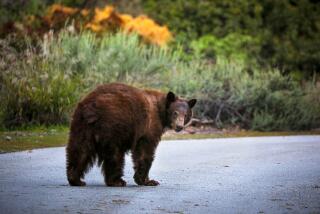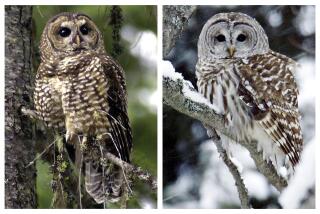Aim Is to Thin Herd, Protect Big Game : Canada’s Aerial Wolf Hunt Drawing Howls of Protest
SEATTLE — In the dead of winter in remote forests near the top of the world, hunters fire semiautomatic rifles from helicopters at packs of gray wolves that are unable to outrun death in the deep snow.
The men with the guns are on government business.
The aerial hunt, in which packs are lured into clearings baited with dead moose, is part of British Columbia’s wolf management program. It has stirred up more intense debate than any wildlife issue since Canada halted the hunting of harp seal pups off its east coast five years.
“Wolves elicit tremendous emotion in people,” said Ralph Archibald, a wildlife biologist and carnivore specialist with the Wildlife Branch of the province’s Ministry of Environment and Parks. “We’re attempting to separate the emotional and sociopolitical issues from the technical ones. It’s very easy to say, but very difficult to do.”
Wolf Numbers Dwindling
Since 1982, government agents have killed 1,000 wolves in an attempt to allow the herds of elk, moose, caribou, mountain sheep and other large game animals to expand in numbers. The provincial hunting industry, which generates more than $35 million in revenues each year, has helped to sponsor the wolf kill in past years.
Ministry officials believe the program is working, but environmentalists and some biologists argue that it is merely depleting the wolf population of British Columbia, which has dropped by tens of thousands of animals in the last 50 years, to 7,000 or fewer.
“I give the wolf 10 to 15 years in British Columbia,” said biologist Jack Laufer, a director of the Northwest Wildlife Preservation Society in Vancouver, B.C. “They kill them on Vancouver Island because they’re near deer. They kill them in the south because they don’t want any wolves in their cattle. They kill them in the north because they eat moose. It’s getting to the point where the wolf has nowhere to go.”
Once plentiful across the northern hemisphere, wolves have been shot, trapped, burned and hanged to extinction in much of their natural habitat. An estimated 20,000-24,000 wolves now live in North America, mostly in Alaska and Canada. Of the 24 subspecies that once roamed freely, at least eight are extinct, including two native to British Columbia.
Emotions Polarized
Wolves are protected as an endangered species in the lower 48 United States and programs are under way to reintroduce them where they have disappeared. Canada does not consider the wolf threatened, although it is regarded as such by the International Union for Conservation of Nature and Natural Resources.
“There are people who love wolves and say they can do no wrong, and those who hate them and think they should be eliminated,” said Don Robinson, chairman of the wildlife committee for the B.C. Wildlife Federation, a group of about 37,000 hunters and fishermen who support the control program. “The truth is probably somewhere in between. Wolves have a right to be here but, like rats, they sometimes impinge on what man wants to do.”
Proponents say the program will stop the decimation of big-game populations that has been occurring since the 1970s. Environmentalists and some biologists argue that the government data used to justify thinning wolves are flawed. They say the studies did not consider other factors such as poaching, increased hunting and habitat losses.
Concerned people in the United States have urged that American tourists boycott British Columbia until the wolf hunts stop. Howling protesters, several dressed in polyester wolf costumes, recently chained themselves to the door of a fur shop on Rodeo Drive in Beverly Hills to call attention to the hunt.
Province officials are scrutinizing the data used to justify the last three aerial hunts to determine if the program should be changed, a review prompted in part by public outcry and dissent within the ministry itself.
No hunt has been scheduled for this winter, pending completion of the review, but environmentalists are poised to demonstrate in the Kechika and Muskwa valleys of northeastern British Columbia, where the kill has taken place three of the last four years.
One group, Friends of the Wolf, has plans for a “Wolf Rendezvous” this month to disrupt the Muskwa hunt. Three directors of the group will parachute into the valley, where other protesters will meet them.
Elk, caribou, moose, deer and bison roam the rugged region, as do the wolves. Cougars and grizzly and black bears share the habitat. It is also home to guide-outfitters, hunters, trappers, Indians, conservationists, government biologists and foresters. It is a popular vacation spot for foreign hunters. Many Americans and Germans pay thousands of dollars for the guides and equipment needed to bag trophy animals.
“Not only have you got more rich natural systems up there than just about anywhere else, you’ve also got this God-awful mish-mash of human user groups who all have conflicting views,” said Dr. Gordon Haber, a wildlife scientist whom conservation groups have asked to review the Kechika-Muskwa wolf-control program. He plans to release his report later this winter.
“When you throw all the principals in the same pot, and they all start going at each other--which is essentially what’s going on down there--you find yourself with a very interesting problem,” said Haber, who has spent 25 years studying Alaskan wolves from his home north of Anchorage.
Wolves are fair game year-round on Vancouver Island, and in September, the government opened the area north of Montana to wolf hunting and trapping for the first time in 20 years. The season was canceled less than two months later, however, to avoid jeopardizing the U.S. wolf-recovery program.
Aerial hunting was begun in 1984 on the recommendation of government biologist John Elliott, whose research was used to justify the Muskwa hunt. Elliott concluded that caribou populations in northeastern British Columbia had fallen 75%, mountain sheep by 50% and moose by 80%.
Protest was mobilized after it became known that private big-game hunting groups were helping to finance the wolf kill. The aerial hunt was suspended in 1986 but resumed last year, when 125 wolves were killed.
“Someone sitting in a helicopter shooting wolves doesn’t fit the image of a wildlife biologist most people have,” Archibald said. “But, looking at it practically, shooting wolves is the most humane and efficient way to remove those animals.”
Elliott, who has participated in the kill, has stated the government’s goal as eradication of 75% of the estimated 180 to 400 wolves in Muskwa. Biologists and conservationists believe that government support of wolf control has also resulted in hundreds of unreported kills.
The wildlife preservation society estimated the wolf population in British Columbia at 6,100 as of September. The latest government figure is 7,000, the same as in 1980.
“No one really knows,” said the society’s executive director, Sherry Pettigrew. Lack of an accurate census frustrates ecologists who believe the government should count the wolves and study the predator-prey relationship for at least several years before it begins control programs.
“Nowhere in British Columbia is there any attempt being made to eliminate wolves,” said Dr. Ian McTaggart-Cowan, a renowned biologist, conservationist and wildlife consultant who taught Haber and Elliott as graduate students. “But it’s a difficult situation up there. I have some sympathy for the people saying, ‘Hold on a minute. Don’t go too far until you know in more detail what you need to do to achieve your wildlife management objectives.’ ”
Wolf Seen as Goat
The government insists that recent wolf-control measures are resulting in larger game herds, but other researchers dispute that. Four University of Guelph scientists who reviewed the statistics concluded that the kill had “no biological basis or biological justification.”
Indeed, some wolf experts believe the government program has worsened the situation because single wolves and pairs that survive kill as many or more animals for food than the big, migrating packs.
“To me, it looks like a situation that was terribly mismanaged,” biologist Laufer said. “They have over-killed the amount of moose and caribou they should have . . . but the scapegoat can’t be one of the government biologists or the government.
So it’s got to be the wolf.”
More to Read
Sign up for Essential California
The most important California stories and recommendations in your inbox every morning.
You may occasionally receive promotional content from the Los Angeles Times.









